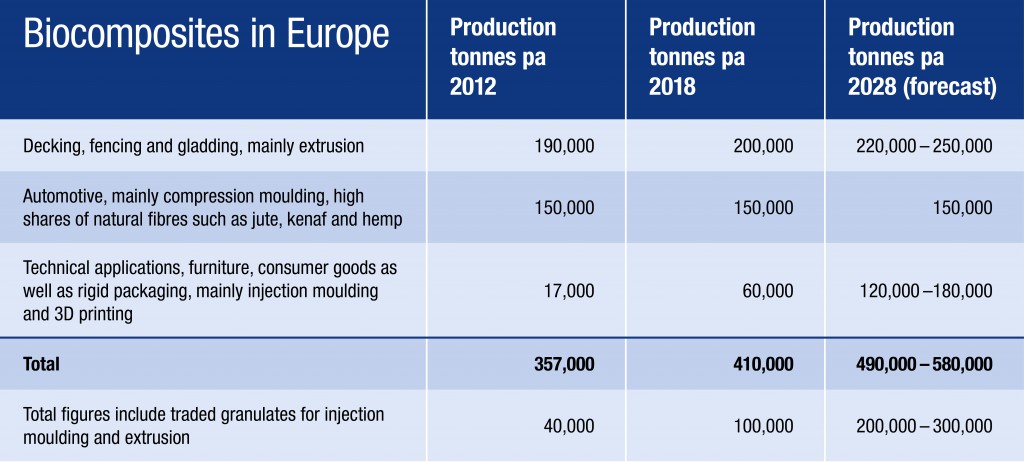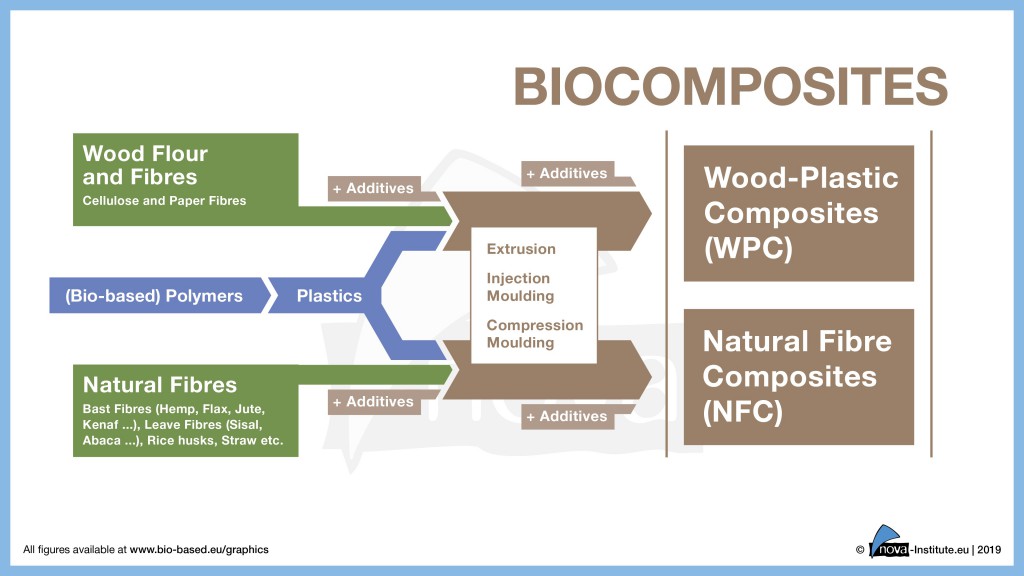Recently, biocomposites have begun to penetrate several additional markets beyond the main sales market of decking. With the latest advances in injection moulding and 3D printing, both Wood-Plastic Composites (WPC) and Natural Fibre Composites (NFC) are of high interest for a multitude of applications and fruitful new options for product differentiation. The “8th Biocomposites Conference Cologne” from 14-15 November 2019 in Cologne offers a comprehensive overview of current developments, product diversity and application areas (www.biocompositescc.com). With an average of 250 participants and 30 exhibitors, the conference has established itself as the leading international conference in the sector of biocomposites.
Visuals, German version and PDF file available at http://nova-institute.eu/press/?id=127
Market development for biocomposites
Recently observed market developments are favourable for biocomposites. The following table shows existing application areas and the potential for market growth. The biocomposite markets continue to grow, stable in established markets like construction and automotive and growing strong in the more recently entered markets of consumer goods and packaging, with new players providing opportunities in innovative applications. The biggest increase is expected for traded biocomposite granulates for furniture, toys, consumer goods and cases, primarily in injection moulding and 3D-printing. According to calculations by the nova-Institute, the production of biocomposite granulates in Europe will double over the coming 10 years.

Biocomposites in the automotive sector
One session of the Biocomposites Conference Cologne focuses on biocomposites in the automotive industry in cooperation with the working group for natural fibres of the AVK – Federation of Reinforced Plastics e.V. In the automotive sector, biocomposites are primarily used for lightweight construction. The resulting lower CO2 footprint plays a crucial role in technical applications and in the automotive industry in general. Wood-Plastic Composites are mainly used for rear shelves, trims for trunks, spare wheels as well as for interior trims for doors. Natural Fibre Composites have a clear focus on interior trims for high-value doors and dashboards, that are processed either with thermoset or thermoplastic matrix.
Another potential market, which was developed recently, are biocomposites for small electric car manufacturers and racing cars. Such smaller car producers are not part of the established automotive value chain and they are looking for ecological lightweight materials with low carbon footprint.
Consumer goods: Biocomposites – the real alternative to plastic
Biocomposites contain wood or other natural fibre and a (bio-)polymer as a matrix. Various production methods including extrusion and injection as well as press moulding or 3D printing can be offered. Most producers still use fossil-based polymers for the production of biocomposites. But meanwhile, there are a lot of bio-based polymers on the market to produce partly or fully bio-based composites which allow to use renewable carbon instead of fossil carbon. Some are biodegradable for special applications: in combination with biodegradable plastics, biocomposites are suitable for the use in agriculture, horticulture and also for utilisations such as filter balls and coffee capsules.
Packaging is the leading application for bio-based polymers. Bio-based polymers do not differ optically from petro-based plastics. In combination with wood or natural fibres, they offer excellent opportunities for the ecological marketing of food trays, biocosmetics or detergents.
Appendix
The 8th Biocomposites Conference Cologne is the world’s leading conference on biocomposites and presents latest developments, trends and market opportunities. The conference is sponsored by Biowert Industrie GmbH – further sponsors are welcome.
Please find more information here: www.biocompositescc.com
The biocomposite markets are stable in established markets like construction and automotive and show strong growth in the more recently developed markets for consumer goods and packaging. This provides ample opportunities for innovative applications from new players: www.biocompositescc.com/programme
Abstract over latest products, technologies or developments can be submitted until end of August: www.biocompositescc.com/call-for-papers
Information on the accompanying exhibition can be found here: www.biocompositescc.com/exhibition-booking
Last but not least, producers and inventors of innovative, new applications for biocomposites are invited to hand in their applications for the innovation award “Biocomposite of the Year 2019” until end of September: www.biocompositescc.com/award-application
Source
nova-Institut GmbH, press release, 2019-06-17.
Supplier
Share
Renewable Carbon News – Daily Newsletter
Subscribe to our daily email newsletter – the world's leading newsletter on renewable materials and chemicals










